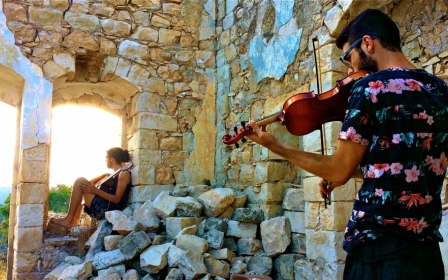IN PICTURES: In Haifa, a 'Museum Without Walls'

Haifa - In the old city of Haifa, a historically Arab city in the north of present-day Israel, history is visible in every corner.
The area bears the stamp of the historical inhabitants of the city. In 1947, when Palestine was under the British Mandate, Haifa was inhabited by roughly 70,000 Palestinians and 71,000 Jews, many of whom had settled there after waves of Zionist immigration in the 19th and 20th centuries from across Europe and North America. When the war that led to the establishment of the State of Israel began, the Palestinian population that did not flee Haifa congregated in Wadi Nisnas.
Today, the area is where the majority of Haifa’s Arab citizens of Israel live, including Palestinians and Syrians from the Syrian Golan Heights, occupied by Israel in 1967. A mixed Christian and Muslim neighbourhood known for its stone buildings, falafel, market, and friendly inhabitants, Wadi Nisnas is also home to more than 60 permanent outdoor art exhibitions called the Museum Without Walls (MWW). You can see art on the walls of buildings abandoned since the 1948 war, on the streets, the courtyards and the stairs used to traverse the hilly landscape of Haifa.
The exhibition was started in 1996 with cooperation from Beit HaGefen, an organisation based in Haifa that “educates towards coexistence, neighbourliness and tolerance by means of communal, cultural and artistic activities” between the many religions living in the city - Jewish, Christian and Muslim (including the Druze).
According to the Israeli Ministry of Foreign Affairs, the MWW “was one of the first venues that held joint exhibitions of prominent and emerging Arab Palestinian and Jewish artists on a regular basis”. Since 1996, the exhibition has featured over 800 works and 500 artists, over 100 of which are exhibited repeatedly.
The MMW aims to bring the coexistence of Haifa to the artistic realm, while simultaneously preserving the city’s historical roots. A number of the works are dedicated to Chaya Touma, a Jewish ceramic artist who married a Palestinian citizen of Israel named Emile Touma.
Emile, a communist philosopher, met Chaya at a Communist Youth Alliance dance class. As a public intellectual and founder of the National Liberation League in Palestine, Emile worked for the creation of two states based on the 1948 United Nations plan, but he also promoted the idea of coexistence between Arabs and Israelis.
The works of Chaya focused on the experience of Palestinian citizens of Israel. They often depict longing, suffering, and hope. Many of her works are featured in the MWW, and they often make reference to the Palestinians who were expelled from Wadi Nisnas in 1948, and other historical struggles of the Palestinian population.
Chaya died in June 2009. The couple’s belief in coexistence extended to the grave; she was buried next to Emile in a Christian Orthodox cemetery. An unusual resting place for an Israeli Jew.
The workshop of the Wadi Nisnas Ceramic Circle created a memorial to Chaya that rests on a wall of a home on the main street of Wadi Nisnas. Featuring brightly coloured ceramic plates depicting faces, fruits and animals, the memorial is hard to miss.
Stay informed with MEE's newsletters
Sign up to get the latest alerts, insights and analysis, starting with Turkey Unpacked
Middle East Eye delivers independent and unrivalled coverage and analysis of the Middle East, North Africa and beyond. To learn more about republishing this content and the associated fees, please fill out this form. More about MEE can be found here.




